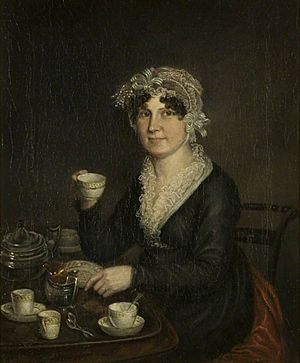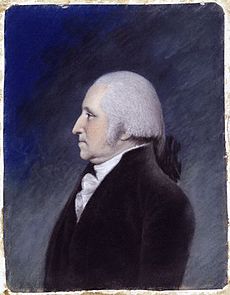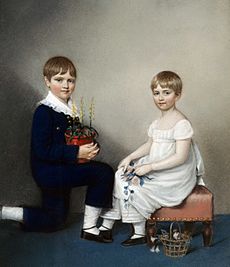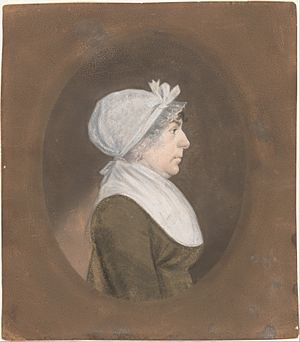Ellen Sharples facts for kids
Quick facts for kids
Ellen Sharples
|
|
|---|---|

Portrait of Sharples, painted by her daughter, Rolinda, c. 1814.
|
|
| Born |
Ellen Wallace
4 March 1769 |
| Died | 14 March 1849 (aged 80) |
| Nationality | English |
| Known for | Painting, Miniaturist |
|
Notable work
|
George Washington, Joseph Banks |
| Movement | Portrait, Silhouette |
| Spouse(s) | |
Ellen Wallace Sharples (born March 4, 1769 – died March 14, 1849) was an English artist. She was known for painting portraits using pastels and small watercolor pictures on ivory. She showed five of her small paintings at the Royal Academy of Arts in 1807. Later, in 1844, she helped start the Bristol Fine Arts Academy by giving a large amount of money.
Contents
About Ellen Sharples
Ellen Wallace was born in Lancaster, England. She learned to draw from James Sharples in Bath. This was her only art training. She married James in 1787. They had two children who also became painters: James Sharples, Jr. (born 1788) and Rolinda Sharples (born 1793). James had two sons from earlier marriages, George and Felix (born 1786), who was also an artist.
Life in America (1794-1801)

Around 1794, Ellen and James moved to the United States. Their journey was difficult because their ship was taken over by a French ship. The family was held captive in Brest for seven months. Ellen later wrote in her diary that this time was "too heart rending to recall," meaning it was very sad to remember.
They finally reached America. Many English artists moved there because people wanted more portraits painted. Living in Washington, DC, James became very successful painting important American leaders, like George Washington. Around 1797, while in Philadelphia, Ellen began painting portraits professionally. She often made copies of her husband's original portraits. Her small copies were just as popular and cost the same as his.
Small portraits, like those the Sharples family made, were a good and cheaper choice compared to the large, formal portraits by artists like Gilbert Stuart. There was a lot of competition from other artists who painted small portraits. To find work, the family traveled a lot. They lived and worked in Philadelphia and New York City. They also traveled through New England in a special carriage that carried their family, their art, and their supplies.
The Sharples children started drawing when they were very young. Ellen personally taught her daughter, Rolinda, how to paint and draw. The children joined the family business when they were still teenagers. Felix was 17, James Jr. was 15, and Rolinda was 13.
Back in England (1801–1809)
In 1801, the family went back to Bath because they were worried about the war between France and America. We know a lot about the family from Ellen Sharples' diaries and letters from this time. In 1803, Ellen wrote about her daughter:
Drawing, reading and instructing my dear Rolinda continues greatly to interest me, as they have done for many years....Mr. S. delights to instruct her in arithmetic and natural philosophy...I attend to her reading, writing, drawing, geography, French, etc.
During this time, Ellen also showed her small paintings at the Royal Academy of Arts.
Another Trip to America (1809–1811)
In 1806, the family planned to return to America. But their ship was damaged in a storm, and they had to go back to port. Felix and James Jr. were able to go to America at that time. James, Ellen, and Rolinda joined them three years later. During their second stay in America, they lived in New York, New Jersey, and Pennsylvania, still painting portraits.
James Sharples became sick in 1810 and died in the winter of 1811. After his death, Ellen, Rolinda, and James Jr. went back to England. Felix chose to stay in America and continued his career as a portrait artist.
Life in Bristol, England (1811–1849)

After her husband died, Ellen stopped traveling so much. She settled permanently in Clifton. She, James Jr., and Rolinda rented an apartment there. The three of them focused on painting portraits. Rolinda started painting larger portraits and complicated group scenes using oil paints. James Jr. lived more independently and continued to paint portraits.
Ellen's diaries stop mentioning Felix in 1823. She never wrote about her children getting married. The family was successful, but both her children died before her. Rolinda died from breast cancer in 1838, and James Jr. died from tuberculosis in 1839. Ellen wrote to a friend about her sadness:
that in my recent losses, my feelings must have been agonizing; for you knew how uniformly exemplary were the affectionate kindness of my dear highly gifted son & daughter to their mother, how devoted she was, placing all her happiness in them....
She was almost 72 years old when she wrote this. When Ellen died in 1849, she left a large amount of money, £4,000, to the Bristol Academy for the Promotion of Fine Arts. This money helped pay for Bristol's first art gallery, which is now the Royal West of England Academy. She had helped start the Academy a few years earlier with a gift of £2,000.
Ellen Sharples' Paintings

Ellen Sharples started her art career by making copies of her husband's pastel portraits. Between 1794 and 1810, her copies were usually 9 by 7 inches on gray or tanned paper. She taught herself how to make small watercolor copies on ivory. From 1803 to 1810, she made these miniature portraits, either as copies or from real life. The money Ellen and her children earned from their paintings made the family wealthy. She wrote in her diary:
Copies were frequently required; these I undertook, and was far successful, as to have as many commissions as I could execute; they were thought equal to the original, price the same: we lived in good style associating in the first society.
After 1810, Ellen did not mention her own work in her diaries. However, the family continued to paint portraits in Bristol. Ellen painted famous people like Joseph Priestley, Martha and George Washington, and Alexander Hamilton. Today, her artworks can be found in many museums in the United States. These include the Metropolitan Museum of Art and the National Gallery of Art. She died in Wybunbury, Cheshire.
Ellen's daughter, Rolinda Sharples, became a well-known oil painter. One of her biggest works was The Trial of Colonel Brereton, painted in 1834. This painting is on display at the M Shed museum in Bristol.
Paintings at the Royal Academy
Ellen Sharples showed her works at the Royal Academy of Art in 1807. This was when her family had moved back to England for a short time. She was listed as "Mrs. James (Ellen) Sharples, Miniature painter." Her exhibited works included:
- H. Brown, Esq. and Dr. Priestley
- T. Newman, Esq.
- Dr. Priestley
See also
- English women painters from the early 19th century who exhibited at the Royal Academy of Art
- Sophie Gengembre Anderson
- Mary Baker
- Ann Charlotte Bartholomew
- Maria Bell
- Barbara Bodichon
- Joanna Mary Boyce
- Margaret Sarah Carpenter
- Fanny Corbaux
- Rosa Corder
- Mary Ellen Edwards
- Harriet Gouldsmith
- Mary Harrison (artist)
- Jane Benham Hay
- Anna Mary Howitt
- Mary Moser
- Martha Darley Mutrie
- Ann Mary Newton
- Emily Mary Osborn
- Kate Perugini
- Louise Rayner
- Rolinda Sharples
- Rebecca Solomon
- Elizabeth Emma Soyer
- Isabelle de Steiger
- Henrietta Ward



